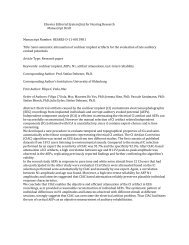Discomfort from sinusoidal oscillation in the pitch and fore-and-aft ...
Discomfort from sinusoidal oscillation in the pitch and fore-and-aft ...
Discomfort from sinusoidal oscillation in the pitch and fore-and-aft ...
You also want an ePaper? Increase the reach of your titles
YUMPU automatically turns print PDFs into web optimized ePapers that Google loves.
Acceleration (rad.s -2 r.m.s.)<br />
10<br />
1.0<br />
ARTICLE IN PRESS<br />
I.H. Wyllie, M.J. Griff<strong>in</strong> / Journal of Sound <strong>and</strong> Vibration 324 (2009) 453–467 463<br />
Wyllie <strong>and</strong> Griff<strong>in</strong><br />
(this study<br />
normalised)<br />
Parsons <strong>and</strong> Griff<strong>in</strong> (1982)<br />
<strong>in</strong> n values are also compatible with those determ<strong>in</strong>ed <strong>in</strong> <strong>the</strong> present study, <strong>and</strong> <strong>the</strong> generally higher n values <strong>in</strong><br />
<strong>the</strong> previous study could be expla<strong>in</strong>ed by <strong>the</strong> much wider range of magnitudes <strong>in</strong>vestigated.<br />
4.6. Prediction of discomfort caused by <strong>pitch</strong> <strong>oscillation</strong><br />
Accord<strong>in</strong>g to current st<strong>and</strong>ards, <strong>the</strong> discomfort caused by mechanical <strong>oscillation</strong> <strong>in</strong> <strong>the</strong> frequency range<br />
0.5–80 Hz can be predicted us<strong>in</strong>g frequency weight<strong>in</strong>gs for translational <strong>and</strong> rotational vibration at <strong>the</strong> seat<br />
<strong>and</strong> <strong>from</strong> translational vibration at <strong>the</strong> feet <strong>and</strong> <strong>the</strong> backrest [10,21]. The method means that with comb<strong>in</strong>ed<br />
<strong>pitch</strong> <strong>and</strong> <strong>fore</strong>-<strong>aft</strong> <strong>oscillation</strong>, seven components can <strong>the</strong>oretically contribute to discomfort:<br />
(i) horizontal acceleration <strong>in</strong> <strong>the</strong> plane of <strong>the</strong> seat (weighted by frequency weight<strong>in</strong>g W d);<br />
(ii) translational acceleration <strong>in</strong> <strong>the</strong> plane of <strong>the</strong> seat due to <strong>pitch</strong>—i.e. g s<strong>in</strong> y (weighted by frequency<br />
weight<strong>in</strong>g Wd);<br />
(iii) <strong>pitch</strong> acceleration <strong>in</strong> <strong>the</strong> plane of <strong>the</strong> seat <strong>in</strong> rad s 2 (weighted by frequency weight<strong>in</strong>g We, witha<br />
multiply<strong>in</strong>g factor of 0.4);<br />
(iv) <strong>fore</strong>-<strong>and</strong>-<strong>aft</strong> acceleration at <strong>the</strong> backrest (weighted by frequency weight<strong>in</strong>g Wc, with a multiply<strong>in</strong>g factor<br />
of 0.8);<br />
(v) translational acceleration at <strong>the</strong> backrest <strong>in</strong> <strong>the</strong> plane of <strong>the</strong> seat—i.e., g s<strong>in</strong> y (weighted by frequency<br />
weight<strong>in</strong>g W c, with a multiply<strong>in</strong>g factor of 0.8);<br />
(vi) <strong>fore</strong>-<strong>and</strong>-<strong>aft</strong> acceleration at <strong>the</strong> feet (weighted by frequency weight<strong>in</strong>g Wb, with a multiply<strong>in</strong>g factor of<br />
0.25);<br />
(vii) translational acceleration at <strong>the</strong> feet <strong>in</strong> <strong>the</strong> plane of <strong>the</strong> seat—i.e, g s<strong>in</strong> y (weighted by frequency weight<strong>in</strong>g<br />
Wb, with a multiply<strong>in</strong>g factor of 0.25).<br />
In practice, many of <strong>the</strong>se components are sufficiently small to be neglected. For example, with high<br />
frequencies of vibration <strong>the</strong> angle of <strong>pitch</strong> is small, so g s<strong>in</strong> y is small, <strong>and</strong> <strong>the</strong> contribution of components (ii),<br />
(v) <strong>and</strong> (vii) is <strong>in</strong>significant.<br />
Hi<strong>the</strong>rto, it has been assumed that ei<strong>the</strong>r <strong>the</strong> components due to g s<strong>in</strong> y are small (as with high frequency<br />
vibration) or that <strong>the</strong> effects are adequately reflected <strong>in</strong> <strong>the</strong> comb<strong>in</strong>ation of this component with <strong>the</strong> <strong>fore</strong>-<strong>and</strong><strong>aft</strong><br />
acceleration measured by nom<strong>in</strong>ally horizontal accelerometers. The results of <strong>the</strong> present study allow <strong>the</strong><br />
assumption to be tested but only provide def<strong>in</strong>itive <strong>in</strong>formation about <strong>the</strong> relative discomfort of <strong>pitch</strong> <strong>and</strong><br />
<strong>fore</strong>-<strong>and</strong>-<strong>aft</strong> <strong>oscillation</strong> when <strong>the</strong> centre of <strong>pitch</strong> is <strong>in</strong> <strong>the</strong> plane of <strong>the</strong> seat surface. This may not be <strong>the</strong> case <strong>in</strong><br />
some practical applications.<br />
Acceleration (m.s -2 r.m.s.)<br />
0.1<br />
0.1<br />
Wyllie <strong>and</strong> Griff<strong>in</strong><br />
(this study)<br />
Wyllie <strong>and</strong> Griff<strong>in</strong><br />
(this study)<br />
Pitch<br />
Fore-<strong>and</strong>-<strong>aft</strong><br />
0.01<br />
0.01<br />
0.1 1 10 100 0.1 1 10 100<br />
Frequency (Hz)<br />
Frequency (Hz)<br />
10<br />
1.0<br />
Wyllie <strong>and</strong> Griff<strong>in</strong><br />
(this study<br />
normalised)<br />
Price (2002)<br />
Fig. 5. Comparison of equivalent comfort contours for <strong>fore</strong>-<strong>and</strong>-<strong>aft</strong> vibration (Price [5]) <strong>and</strong> <strong>pitch</strong> vibration (Parsons <strong>and</strong> Griff<strong>in</strong> [7]) with<br />
equivalent comfort contours determ<strong>in</strong>ed <strong>in</strong> this study. Data normalised to co<strong>in</strong>cide at 1.0 Hz.
















